Aim for quality outcomes, not just outputs — that’s how we can drive customer and business value!
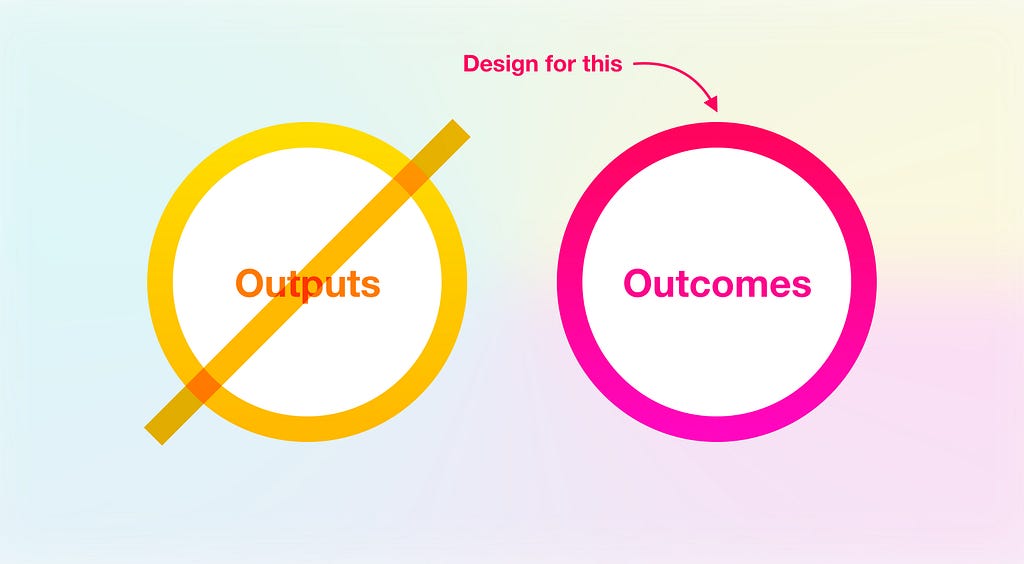
“Start with the customer experience and work backwards to the technology,” Steve Jobs once said. To write a compelling story, start with the ending as a meaningful destination. A customer leaves a five-star review after experiencing good service. What do these statements share in common? Meaningful outcomes.
However, as organisations compete for people’s money and attention, they often focus on creating tangible outputs like intrusive marketing pop-ups or other excessive features. They also prioritise high-level business metrics and feature backlogs over fulfilling customer needs. But despite having a well-designed implementation, there is no guarantee that we can achieve product success.
If we want to put customers at the heart of what we do, we must refrain from focusing solely on outputs. Instead, we must start shifting our thinking to an outcome-oriented mindset. Although change is never easy, we can use frameworks and principles to orient teams to work towards what truly matters — value!
In this story, we’ll cover the following topics:
⛔️ The challenges with focusing on outputs.
🧠 Shifting to an outcome-oriented mindset.
🎯 Using outcome-oriented frameworks.
First, let’s unpack the first topic, which addresses the common problems using an output-focused approach.
Living in an output-focused world
Don’t just think about outputs; consider what truly matters.
The problem root cause of building the wrong things
There are moments when we recall projects that led to wasting time and money, delayed feature releases, and dissatisfied customers. One memory stands out from over a decade ago when I collaborated with co-workers to brainstorm ideas for a new shopping app that leadership was eager to launch. When we shipped the new shiny product to market, we learned we built the wrong thing late in the game!
So, what was the problem’s root cause? A disorganised product backlog? Usability issues? Ineffective marketing? While these may have been factors, they were symptoms of an output-focused mindset. In hindsight, we should have focused on customer outcomes instead of working on a specific tangible output.
The lesson learned is that focusing solely on tangible outputs risks building the wrong things. Instead, we should laser-beam our focus on customer outcomes to avoid wasting time, money, and resources.
The output-focused problem
Product coach Teresa Torres highlights an organisation’s tendency to focus on outputs, “It’s really easy in business — and especially among product teams — to be output focused,” she explains. This mindset is typical in teams that manage their backlogs by assuming problems and experimenting with MVPs without understanding the fuller picture.
Furthermore, leadership often drives strategies using KPIs (Key Performance Indicators) and OKRs (Objectives and Key Results) based on arbitrary impact measures, such as monetary conversion and customer satisfaction scores. Relying solely on high-level business metrics often results in shipping worthless features.
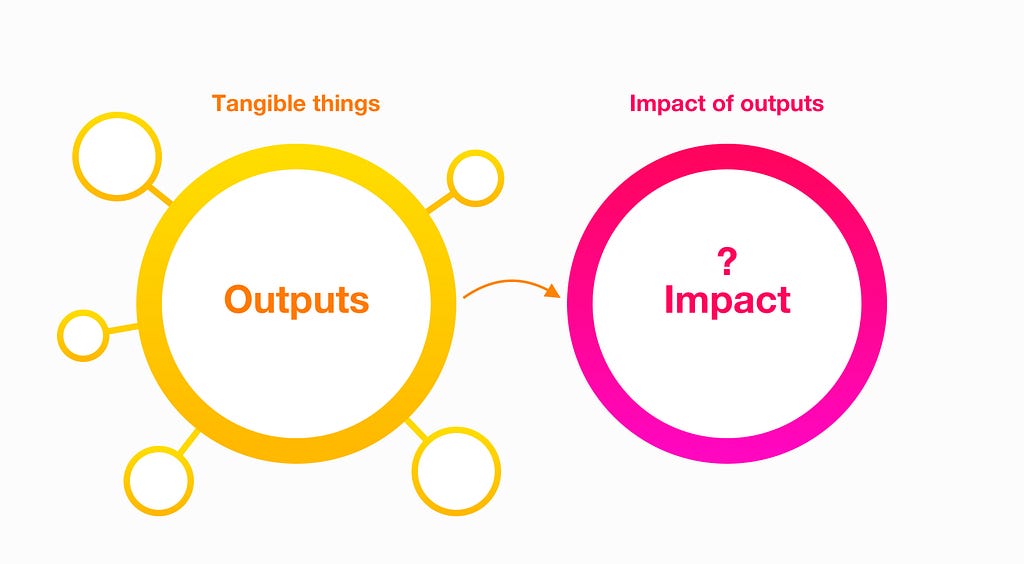
The output-focused mindset can prove costly when we leave learning about customer needs later. Additionally, aligning business objectives with customer goals can be challenging if we don’t understand problems and opportunities early on. Ultimately, failing to determine outcomes can leave us feeling lost, like ships without a lighthouse to guide us.
Shifting to an outcome-oriented mindset
Adopt an outcome-oriented mindset to drive valuable experiences.
People don’t want outputs; they want outcomes
What truly matters are positive outcomes. As Theodore Levitt once said, “People don’t want to buy a quarter-inch drill. They want a quarter-inch hole!” The notion also resonates with any product regardless of its sophistication — people don’t buy products; they buy solutions to their problems.
A popular social media meme perfectly describes the concept of people seeking outcomes. In the video, a lady tests a frying pan for its weight and flipping action in a supermarket. The camera then focuses on another lady attempting to use a frying pan to hit a target.
https://medium.com/media/6583e502e9b2d8bf7db971aceb1e4d90/href
Focusing on outcomes encourages us to maintain a customer-centric mindset that prioritises peoples’ needs and situations — from ordering a taxi to finding a kitchen-based weapon. Instead of fixating on specific outputs or a high-level metric, we strive to consider the complete picture of the desired behaviours we seek to achieve.
Torres elaborates on the importance of focusing on the effects of the products we create and introduce to the market. “Shifting to an outcome mindset is more about what impact those outputs have.”
“When we manage by outcomes, we give our teams the autonomy, responsibility, and ownership to chart their own path.” — Teresa Torres.
Additionally, Torres suggests that shifting from rigid, predetermined roadmaps towards outcome-based management is beneficial, which empowers us to discover optimal solutions independently. “When we manage by outcomes, we give our teams the autonomy, responsibility, and ownership to chart their own path.”
When adopting an outcome-oriented mindset, we identify the desired outcomes before focusing on specific outputs. Doing so reframes the typical question, “What feature do we build next?” to “What are the outcomes we want to achieve?” Similar to focusing on a North Star, it shifts our perspective to defining the relationship between customer problems and organisational impact.
How do we define outcomes?
In his book Outcomes Over Output, Joshua Seiden defines an outcome as “An outcome is a change in human behaviour that drives business results.” He also explains, “Outcomes are the changes in customer, user, and employee behaviour that lead to good things for your company, your organisation, and whomever is the focus of your work.”
“An outcome is a change in human behaviour that drives business results.” — Joshua Seiden.
Let’s unpack some examples of outcomes in which customers find value in interacting with a product or service to get something done:
- Access timely and relevant healthcare treatment and advice.
- Travel faster, safer, and conveniently when using public transport.
- Obtain resources customised to meet individual learning requirements.
- Follow fitness plans tailored to your body and lifestyle.
- Perform hands-free activities to accommodate permanent or temporary disabilities or situations.
- Reduce the carbon footprint from daily activities, such as commuting and working.
Intricate outcomes
There are also certain complex situations that most organisations would classify as edge cases. However, building for these scenarios can be crucial in leveraging the customer experience and brand reputation. Here are some sample behaviours we might not expect to perform daily yet consider as desired outcomes.
- Manage subscriptions and policies following a bereavement.
- Consume meals that cater to complex allergies or dietary restrictions.
- Control how a company manages personal data.
- Make a booking or purchase, find information, or perform an everyday website or mobile app behaviour that works with a permanent or temporary physical or mental impairment.
- Provide continuous consent to safeguard against potential stalking or partner abuse.
As per the last two examples, many organisations still approach accessibility as an afterthought. Furthermore, they often overlook designing for safety and ethical technology.
Organisational outcomes
In addition to customer and product-related behaviours, outcomes also apply to an organisation. Some target outcomes might include:
- Helpline operators spend less time answering common questions and more on complex queries.
- An I.T. Operations team quickly identifies problems in website performance and health.
- Product teams make faster, informed decisions based on customer research insights.
- Leadership prioritises focusing on outcomes.
- A safe, creative culture maintains high employee morale and retention.
Based on our assessment of various potential outcomes, none provide a specific output. However, they describe customer or organisational behaviours that can aid us in identifying relevant outputs.
Next, we’ll review some available frameworks to assist us in adopting an outcome-oriented mindset.
Using outcome-oriented frameworks
Guide teams using tools and techniques to work towards outcomes.
Orient teams towards outcomes
Many frameworks prioritise solutions and outputs as the ultimate goal, which risks waste and customer dissatisfaction. However, when we shift our focus on outcomes, we adopt a more holistic approach to problem-solving and innovation. Furthermore, this mindset promotes collaboration with cross-functional teams, fostering a shared vision leading to more tremendous success.
Outcome-oriented frameworks help us to achieve precisely that! Therefore, I have hand-picked three models that can provide us with the tools and techniques to focus on desired outcomes. Let’s take a look at each one.
The Program Logic Model (PLM)
In 1998, the W.K. Kellog Foundation introduced the Program Logic Model (PLM) to guide organisations, communities, or systems in connecting planned work to expected outcomes. It enables us to identify strengths, weaknesses, and optimal strategies and adjust accordingly.
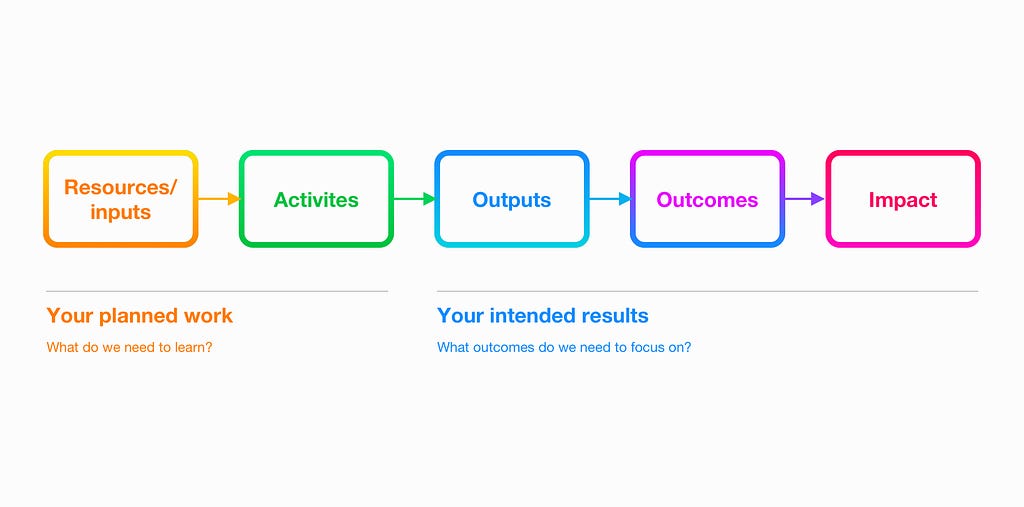
“Using evaluation and the logic model results in effective programming and offers greater learning opportunities, better documentation of outcomes, and shared knowledge about what works and why.” — W.K. Kellog Foundation.
The model consists of a sequence of steps, including:
- Resources/inputs: Refer to the available components, such as people, materials, funds, and other necessary items.
- Activities: Consist of processes, tools, events, technology, and actions intended for a project.
- Outputs: Represent the direct products of project activities.
- Outcomes: The specific changes in behaviour, knowledge, skills, status, and level of functioning.
- Impact: The intended or unintended results of the outcome.
The PLM provides the building blocks for connecting our planned work with the intended changes or results we hope to achieve. Furthermore, its clear and straightforward structure is well-suited for establishing an outcome-oriented framework.
The Opportunity Solution Tree (OST)
Teresa Torres often shares inspiring stories about the OST on social media. She’s also written about it in her book Continous Discovery Habits. The OST is a visual tool that can significantly improve a product team’s efficiency and results. “It’s a simple way of visually representing how you plan to reach a desired outcome,” she explains. “It helps you to make your implicit assumptions explicit.”
“An Opportunity Solution Tree is a simple visual that helps you reach a desired outcome.” — Teresa Torres.
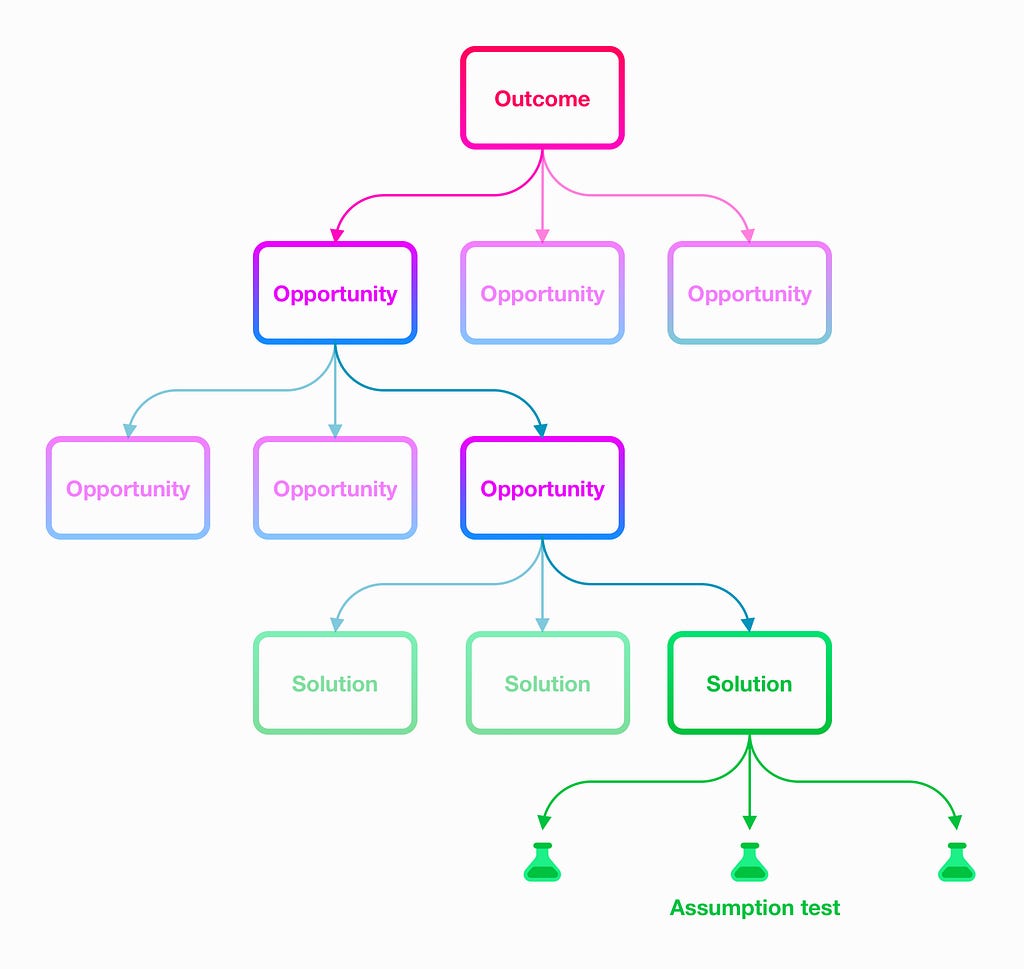
Developing an OST begins by identifying the desired outcome as the root. Through continuous research (small, frequent activities), we frame problems, including customer needs, pain points, and desires, as branching opportunities, which might look like:
- I’ve run out of episodes for my favourite show; I need something new to watch.
- I can’t physically access my doctor’s surgery and need urgent medical advice for my dependent.
- I need access to course materials tailored to my neurodivergent learning needs.
- I want to discover and follow a fitness plan that works around my busy schedule.
Once we frame our problems, we generate and evaluate solutions for each opportunity through assumption tests to determine the highest customer and business value. Furthermore, regularly testing our assumptions can eliminate what doesn’t work and give us more ammunition to say “No” to invalid ideas.
Outcome-based service map
In her article, Outcome-Based Serving Mapping, Service Designer Marie Cheung introduces the concept of mapping outcomes using service blueprint principles. She explains that we can map customer pain points towards existing and desired outcomes as part of an end-to-end journey.

“I wanted to create a simple framework that would enable anyone to start thinking and working in this way and to take others along with them in the journey of making our services more user-centred.” — Marie Cheung.
Cheung recommends using generative research to define the users (including customers and service-level roles), their goals, and the high-level journey stages that lead to their desired outcomes. Then, fill the gaps with activities that help users achieve their goals. Additionally, we can use the process to support research, create a roadmap, and improve the overall service or journey.
Design for meaningful outcomes
To realise value, we must focus on meaningful outcomes.
An outcome-oriented mindset drives value
Shifting our focus from outputs towards outcomes is essential for meeting customer needs and behaviours. We can also better understand what truly matters, avoid building the wrong things, and ultimately drive value for customers and organisations.
Additionally, we can use outcome-oriented frameworks like the PLM or the OST to align our strategies towards achieving meaningful outcomes. They equip us with the necessary tools and techniques to avoid getting sidetracked by outputs and instead keep our focus on the desired outcomes throughout a product lifecycle.
Tips for adopting an outcome-oriented mindset
To summarise this article’s key themes, here is a list of takeaways for adopting an outcome-oriented mindset. Additionally, I have created a diagram to illustrate how some principles may interconnect as part of a broader ecosystem.
- Learn: Use generative research (including interviews) to uncover customer needs, problems, and goals while revealing unexpected opportunities for innovation.
- Define: Specify and connect the desired outcomes to problems framed as opportunities.
- Plan: Establish a clear set of measurable and achievable objectives aligned to the desired outcomes.
- Test: Evaluate solutions by testing with customers and prioritise those that best achieve our desired outcomes.
- Measure: Combine qualitative and quantitive data to create a fuller picture of the impact of our outcomes.
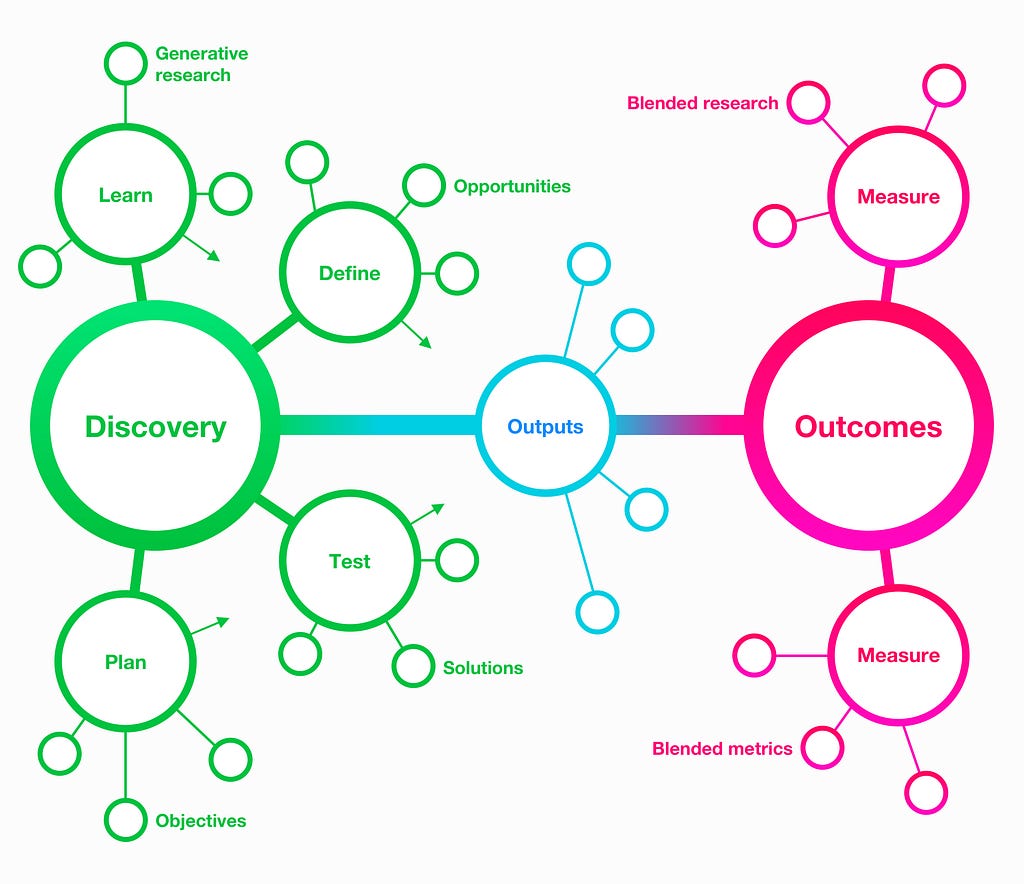
The outcome-oriented ecosystem map illustrates a relationship between two crucial areas: discovery and outcomes. Discovery-related activities provide the intelligence required to build the relevant outputs. After that, we blend different research and analytical methods to measure the impact of outcomes, enabling us to create a more complete picture and determine if we’re on the right track to realising value.
Furthermore, the outcome-oriented ecosystem is like a living organism fostering constant realignment. For instance, if the measured outcomes indicate that we are not meeting customer needs, we can adjust our objectives by incorporating new research insights or focusing on different opportunities.
With our key takeaways, let’s shift our perspective and focus on maximising relevant outcomes, not just outputs. Learn early and work towards creating something meaningful where we can all find value.
References
- Why This Opportunity Solution Tree is Changing the Way Product Teams Work by Teresa Torres
- Every Product Needs a North Star Metric: Here’s How to Find Yours by Sandhya Hegde
- Continuous Discovery Habits by Teresa Torres
- Outcomes Over Output by Joshua Seiden
- Logic Model Development Guide by W.K. Kellogg Foundation
- Outcome-based service mapping by Marie Cheung
Design for meaningful outcomes was originally published in UX Collective on Medium, where people are continuing the conversation by highlighting and responding to this story.